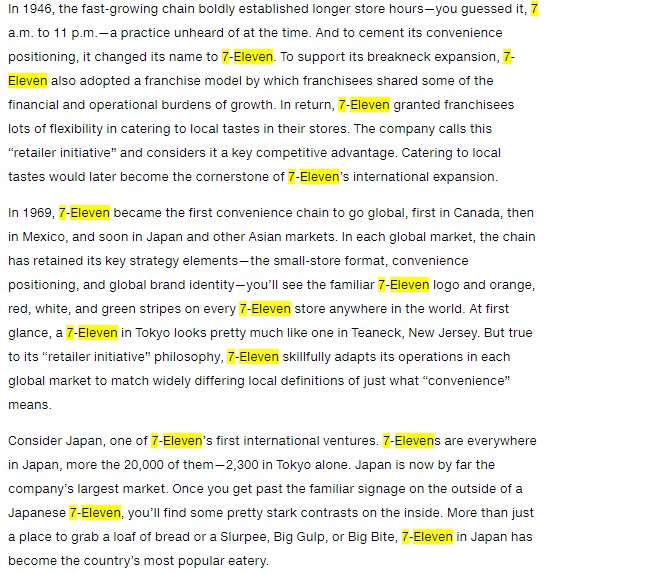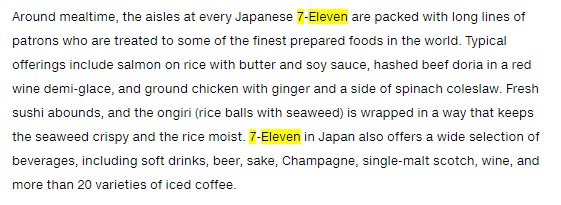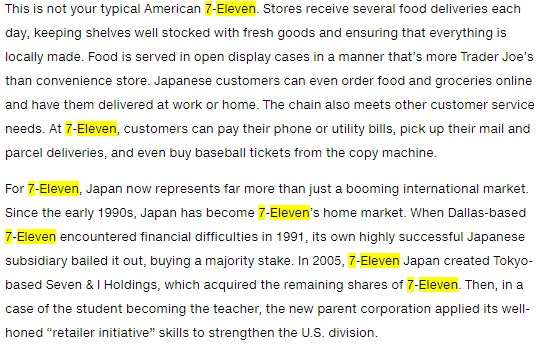Within the U.S., describe their franchise model and how it gives them a competitive advantage.
Describe how the have adapted as they expanded into the global market.
Americans love convenience stores. There's one just around the corner, and they're open long hours, seven days a week. Whether it's big chains like T-Eleven and Circle K or more-local favorites like Illinois-based Moto-Mart, Nebraska's Bucky's, or Minnesota's own Pump 'N lv'lunch, convenience stores have become an American mainstay for buying snacks, gas, or a few fill-in items between major grocery store trips. It's hard to imagine a convenience store being anything else. But as it turns out, the convenience store concept doesn't translate in a standard way across international borders. Just ask ?Eleven, a chain that's sweeping the planet. 7' Eleven is America's largest convenience store chain, with more than 9,000 LLS. stores in 34 states. But it's also the world's biggest convenience chain, with more than 66,000 stores in 1]" countries generating nearly $96 billion in annual worldwide sales. 1" Eleven's global success results from carefully adapting its overall convenience format to unique marketbymarket needs. ?Eleven began in 192? when \"Uncle Johnny" Jefferson Green started selling milk, bread, and eggs from the dock of the Southland Ice Company where he worked, often on Sundays and evenings when regular grocery stores were closed. Within '10 years, Southland Ice Company had opened ED such outlets selling basic stapleseverything from canned goods to cold watermelon. As the chain grew, the convenience store concept took rootsmall stores in convenient locations, a limited line of high-demand products, speedy transactions, and friendly service. In 1945, the fast-growing chain boldly established longer store hoursyou guessed it, T am. to '11 p.rn.a practice unheard of at the time. And to cement its convenience positioning, it changed its name to T-Eleven. To support its breakneck expansion, ? Eleven also adopted a franchise model by which franchisees shared some of the financial and ope rational burdens of growth. In return, F-Eleven granted franchisees lots of flexibility in catering to local tastes in their stores. The company calls this \"retailer initiative" and considers it a key competitive advantage. Catering to local tastes would later become the cornerstone of fEleven's international expansion. In 1959, TEleven became the first convenience chain to go global, first in Canada, then in Mexico, and soon in Japan and other Asian markets. In each global market, the chain has retained its key strategy elementsthe small-store format, convenience positioning, and global brand identityyou'll see the familiar f-Eleven logo and orange, red, white, and green stripes on every TEleven store anywhere in the world. At first glance, a ?Eleven in Tokyo looks pretty much like one in Teaneck, New Jersey. But true to its r'retailer initiative" philosophy, ?Eleven skillfully adapts its operations in each global market to match widely differing local definitions of just what "convenience" FI'IEEFIS. Consider Japan, one of ?Eleven's first international ventures. T-Elevens are everywhere in Japan, more the Eil of them2,330 in Tokyo alone. Japan is now by far the company's largest market. Once you get past the familiar signage on the outside of a Japanese YEleven, you'll find some pretty stark contrasts on the inside. More than just a place to grab a loaf of bread or a Slurpee, Big Gulp, or Big Bite, T-Eleven in Japan has become the country's most popular eatery. Around mealtime, the aisles at every Japanese 7-Eleven are packed with long lines of patrons who are treated to some of the finest prepared foods in the world. Typical offerings include salmon on rice with butter and soy sauce, hashed beef doria in a red wine demi-glace, and ground chicken with ginger and a side of spinach coleslaw. Fresh sushi abounds, and the ongiri (rice balls with seaweed) is wrapped in a way that keeps the seaweed crispy and the rice moist. 7-Eleven in Japan also offers a wide selection of beverages, including soft drinks, beer, sake, Champagne, single-malt scotch, wine, and more than 20 varieties of iced coffee.This is not your typical American 7-Eleven. Stores receive several food deliveries each day, keeping shelves well stocked with fresh goods and ensuring that everything is locally made. Food is served in open display cases in a manner that's more Trader Joe's than convenience store. Japanese customers can even order food and groceries online and have them delivered at work or home. The chain also meets other customer service needs. At 7-Eleven, customers can pay their phone or utility bills, pick up their mail and parcel deliveries, and even buy baseball tickets from the copy machine. For 7-Eleven, Japan now represents far more than just a booming international market. Since the early 1990s, Japan has become 7-Eleven's home market. When Dallas-based 7-Eleven encountered financial difficulties in 1991, its own highly successful Japanese subsidiary bailed it out, buying a majority stake. In 2005, 7-Eleven Japan created Tokyo- based Seven & I Holdings, which acquired the remaining shares of 7-Eleven. Then, in a case of the student becoming the teacher, the new parent corporation applied its well- honed "retailer initiative" skills to strengthen the U.S. division.1lIliI'herever it operates, Y-EIeven seeks to become a part of the local culture. For example, in tech-crazed Taiwan, Y-EIevens are stocked full of pu rchasable electronics like iPads. They serve as a place to pay everything from credit card and utility bills to traffic tickets and property taxes. Some will even do your dry cleaning. Conversely, on weekends in Hong Kong, you'll find people hanging around and drinking at the local \"Club ?\"yes, we're talking about the TEleven. "Young locals and 'gweilo' {foreigners} swarm these places, drinks in hand, making the convenience store look like an open aired bar,\" notes an observe r. In Hawaii, where people are obsessed with Spam canned cooked meat, f-Elevens serve up a positively sinful dish called Spam musubi, a slice of fried Spam on top of a bed of rice and wrapped in nori dried seaweed. In stark contrast, in Denmark, the chain's healthconscious customers are more inclined toward crunchy granola and paleo salads. Whereas American customers enjoy neon-colorSlurpees, calorie-rich Etig Gulps, and roller dogs, TElevens in Denmark offer freshly prepared sandwiches on artisanstyle bread and fresh-cooked kebabs. Snacks include proteinpacked muesli bars, hummus, a variety of healthy salads, and lots of other fast, healthy options. \"Denmark is ranked as the happiest country in the world,'I says an analyst. "?Eleven, of all places, is aiming to make it the healthiest, too." Thus, 7-Eleven's fine-tuned global marketing strategy has made it the world's largest convenience store chain. Wherever 7-Eleven operates, its overall brand identity and convenience positioning remain constant: "At 7-Eleven, our purpose and mission is to make life a little easier for our guests," says the company, by "giving customers what they want, when and where they want it." But 7-Eleven knows that those whats, whens, and wheres can shift dramatically from market to market. The real secret is to weave the global 7-Eleven strategy into the fabric of each local culture












